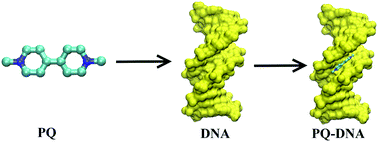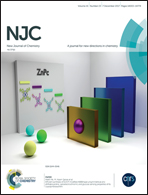Exploring the binding mechanism of paraquat to DNA by a combination of spectroscopic, cellular uptake, molecular docking and molecular dynamics simulation methods†
Abstract
This paper describes a detailed investigation on the interaction between paraquat, an organic herbicide, and DNA using experimental and computational approaches. According to the results arising from the fluorescence spectra, voltammetric measurements and molecular modeling studies, it can be concluded that paraquat is a minor groove binder of DNA and preferentially binds to A–T rich regions. This was substantiated by displacement studies with Hoechst 33258, a known minor groove binder. In addition, the thermodynamic and molecular modeling parameters showed that hydrophobic interaction via paraquat inside the DNA minor groove plays a major role in binding. Also, MCF-7 cells were incubated with paraquat and the bright fluorescence intensity was observed spread all over the cells. Computational experiments showed that the most probable mode of action of paraquat as a DNA binding agent is via intercalation of 4-pyridyl rings between AT base pairs with the linker binding to the minor groove.



 Please wait while we load your content...
Please wait while we load your content...